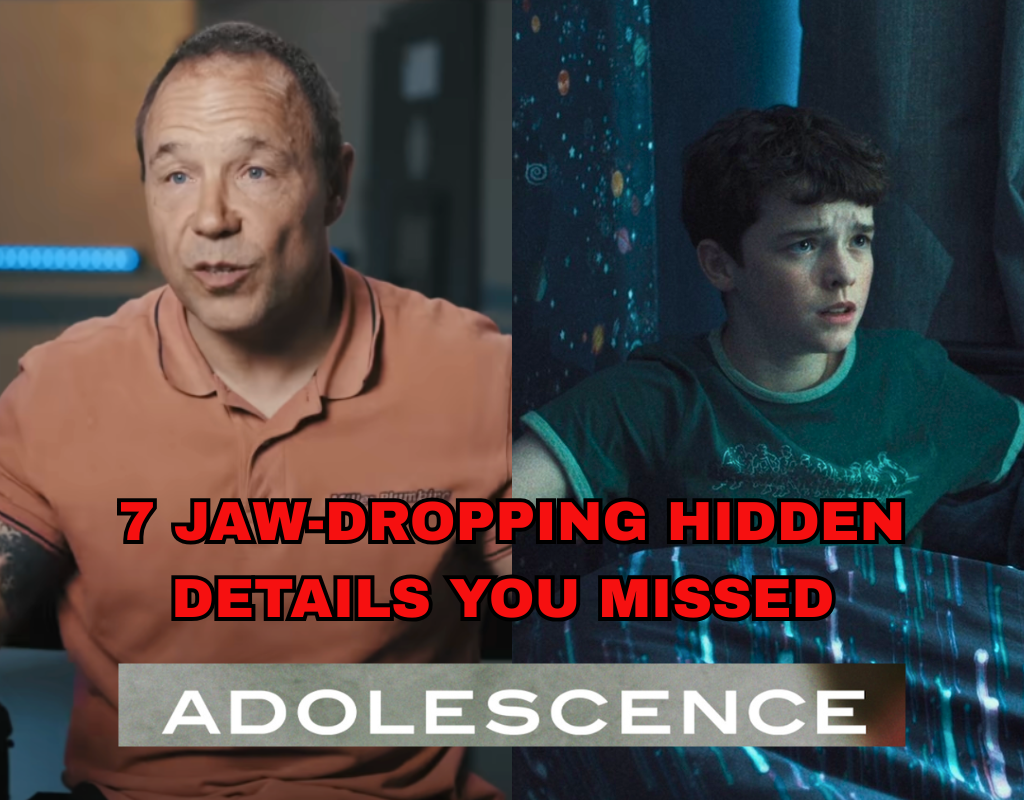Now Reading: Beyond the Hype: 5 Reasons Why Netflix’s ‘Adolescence’ is a Masterclass in Storytelling
-
01
Beyond the Hype: 5 Reasons Why Netflix’s ‘Adolescence’ is a Masterclass in Storytelling
Beyond the Hype: 5 Reasons Why Netflix’s ‘Adolescence’ is a Masterclass in Storytelling

Explore the chilling reality of Netflix’s ‘Adolescence.’ A deep dive into its themes of youth, digital life & the making of a modern masterpiece.
Do you ever come across a show that not just entertains you but literally haunts you? A show that makes you question the very fabric of society, the vulnerability of adolescents, and the creepy power of the digital universe?
This is precisely the experience of watching Netflix’s ‘Adolescence,’ a British crime drama that has gained global viewership since it was released on March 13, 2025.
It reached #1 on Netflix charts within four days with over 24 million viewers and has kept breaking records, even outperforming some of the Stranger Things series.
But ‘Adolescence’ is not just a triumph because of its compelling plot or great acting; it’s also a triumph of daring filmmaking and incisive social commentary.

Beneath the initial shock value of its premise – a 13-year-old boy, Jamie Miller, being tried for murder – is a painstakingly assembled story constructed to captivate, to infuriate, and ultimately, to leave an indelible mark.
This is not a program you watch; it’s an experience you suffer, that forces you to face unpalatable truths about the world we live and the innocence we risk losing.
We shall take a peek into the layers of genius that propel ‘Adolescence’ as one of the most crucial series of 2025, studying the innovative methods, the true-to-life performances, and the haunting real-world reflections that seal its masterwork status.
The Unbroken Gaze: A Daring Cinematic Experiment
The most obvious and striking aspect of ‘Adolescence’ is its groundbreaking filming style: all four of its episodes are filmed in a single, uninterrupted take.
No edits, no cuts, no covert transitions. From the frenetic police raid of Episode 1 to the intense psychological assessment of Episode 3, the camera is an unflinching observer, gliding effortlessly through cluttered rooms, busy schools, and peaceful home environments.
Director Philip Barantini, whose last film was the astounding one-shot “Boiling Point” (in which Stephen Graham was also featured), makes this technique a gesture of gimmickry into a deep storytelling support. The absence of cuts forces an unparalleled level of immersion.
You, the viewer, are no longer an outsider observer; you are launched into the very tissue of each second, breathing in the same air as the actors, feeling the same airlessness of their being trapped, the same crushing leadenness of their hopelessness.
Consider the opening of Episode 1: the sudden, jolting plunge into Jamie’s home. The camera does not cut away to spare you the stomach shock; it stays with the officers, and then with Jamie, after every flinch, every dazed look, every step of his horror-stricken arrest procedure.

This unflinching eye prohibits any emotional distance, exaggerating naked fear and confusion of a child suddenly deprived of his world.
Similarly, Episode 3, this bleak two-hander between Jamie and a clinical psychologist (played with frosty precision by Erin Doherty), survives on this unbroken tension.
Every shade of conversation between them, every telling shift of posture, is captured uninterrupted, and the chess match of psychological mind games is so heightened as to be almost agonizing.
This “one-shot magic” demands a degree of accuracy from cast and crew that is unprecedented. Actors have to be able to execute perfect, hour-long scenes, with each mark and each emotional beat exactly.
Cameramen are reduced to choreographed dancers who have to dance through tight corridors while maintaining the camera steady.
Technical rehearsals were reported to have been as arduous as shooting itself, with miniature sets used to choreograph every move.
The final result is a masterwork of film art that raises the emotional stakes and grounds the story in unflinching truth. It’s a testament to how constraints on creativity can push art into bold territory, making an experience that’s at once technically bold and emotionally devastating.
Owen Cooper’s Unforgettable Adolescence Debut: A Star Is Born
Although ‘Adolescence’ boasts a cast of grizzled old hands like Stephen Graham (who also co-created and co-wrote the series) and Ashley Walters, it is the performance of 15-year-old Owen Cooper as 13-year-old Jamie Miller that properly anchors the series and sends shivers down your spine.

It’s Cooper’s first-time-ever acting experience, something which is almost unbelievable given the raw talent, vulnerability, and downright scary depth he brings to an absolutely grueling character.
Cooper navigates Jamie’s emotional tides with a wisdom years his senior. One minute he is a scared, lost kid swept along on an overwhelming situation, wet napping his pajamas on the first arrest.
The next, he is an ice-as-many, standoffish figure in a psych interview, showing flashes of hair-raising intelligence and unnerving disrespect. His ability to alternate between these affects, often within the course of one uninterrupted take, is jaw-dropping.

Critics have been singing Cooper’s praises across the board, some going as far as calling it one of the greatest child performances in years, drawing comparisons to early Jodie Foster or Leonardo DiCaprio. Director Philip Barantini has spoken about Cooper’s natural talent, praising how the young actor learned every note, but also brought his own initiative and improvisation to the part, even in the heavily choreographed one-shot environment.
The third episode, though, is where his depth is truly revealed as he dominantly occupies the screen in a lengthy, tense discussion with Erin Doherty and peels away the layers of trauma, manipulation, and early-onset misogyny that lie beneath Jamie.
Owen Cooper’s performance is significant because Jamie is not a cardboard character. He is a product of his environment, his internet consumption, and his unexpressed fears.
Cooper helps you see the lost boy behind the hardened shell, even as your mind reeling tries to deal with the horrible accusations against him. His performance elevates ‘Adolescence’ from an ordinary crime thriller to a nuanced character study, giving face to the complex struggles of navigating the modern world as a tender teen.
The Chilling Echoes of Reality: Inspiration Too Wild to Ignore
‘Adolescence’ is so powerful because it is so, so deeply rooted in the brutal realities of contemporary society.
The show was conceived by co-creators Jack Thorne and Stephen Graham as a response to a deeply unnerving trend in contemporary society: the increase in knife crime among teenagers in the UK, with particular attention to those committed by younger boys against females.
Stephen Graham was personally affected by news reports on such crimes in real life and wanted to explore the “why” behind such crimes.
In his opinion, he asked himself, “What’s breaking in society?” and wanted to know why teenage boys are inclined to such violence.
While the series has not been based on one specific true account, it draws strong inspiration from the social ills and individual experiences that have emerged out of these situations.

The series unflinchingly examines the corrosive influence of the “manosphere” and “incel” subculture on vulnerable young boys.
Through observations like the seemingly harmless emojis used in social media status updates that get decoded to reveal allusions to extremist online collectives, ‘Adolescence’ puts into sharp relief the ruthless manner in which extremist ideologies are radicalizing youngsters online by degrees with hardly any monitoring by parents or teachers.
The “red pill” idea and distorted views of gender relations are intertwined in Jamie’s character, demonstrating the malleability of minds into hate-ridden narratives within the echo chambers of the internet.
The fact that it’s based on reality makes ‘Adolescence’ a more than just a crime drama; it’s an inscription of urgent social concerns.
It forces parents, educators, and indeed all viewers, to face uncomfortable questions about online safety, mental health, social media pressures, and the breakdown of traditional systems of support for young people.
It is a timely, chilling wake-up call, highlighting the invisible dangers lurking in the digital spaces teenagers spend so much time in.
Prime Minister Keir Starmer even publicly supported the series, recommending it be shown to schools to encourage discussion of misogyny and violence against women, highlighting its real-life effect.
The Art of Subtlety: Concealed Layers and Emotional Depths
Apart from the sheer genius, ‘Adolescence’ is brimming with subtle artistic choices that contribute to its emotional depth and thematic richness.
These are the kinds of things that really become evident on repeat viewing, giving credit to the show’s exceptional level of craftsmanship:
The Colors Tell a Secret Story:
Pay close attention to the shifting color scheme throughout the series. Episode 1, during which Jamie is arrested, is full of garish greens and purples, visually capturing his terror, disorientation, and moral rot in the scene.
Blues and grays gradually make a soft appearance later in the series, particularly in Episode 4, symbolizing vulnerable hope, the slow healing process, and the attempts at Jamie’s family to mend.
This accidental game with color subtly guides the viewer on an emotional journey.
The Shadowy Figure in Episode 1
During the chaotic opening raid in Jamie’s room in Episode 1, a faint silhouette appears near the doorway for a split second before the camera moves on.
This blink-and-you-miss-it detail has sparked extensive fan theories, suggesting it’s a deliberate hint at Katie’s unseen presence, haunting the narrative from its very beginning. In a one-shot production, such details are meticulously planned and embedded, adding layers of symbolic meaning.
The Soundtrack’s Secret Voice
Perhaps the most sweetly heartbreaking subtle thing is actually hidden in the soundtrack. The haunting ballad “Through the Eyes of a Child” during Episode 4, played as Jamie’s father wrestles with his son’s guilt, isn’t music in the background.
It’s performed by actress Emilia Holliday, who portrays Katie, the killed girl. Director Philip Barantini confirmed that the choice was intentional, mentioning they required Katie’s voice and presence to run through the finale so her omission would be palpably felt and her loss emphasized.
This addition makes the song a despairing, bordering-toxic elegy. These unseen layers reveal the attention that was put into every frame of ‘Adolescence,’ so the show’s emotional impact endures long after its immediate seconds.
Why ‘Adolescence’ is a Must-Watch
‘Adolescence’ is more than a mere other British crime show; it’s an essential piece of television which resists categorization. Boasting a spotless 98% “Certified Fresh” rating on Rotten Tomatoes and global critical acclaim (including “TV perfection” by The Guardian), its quality is not in question.
But its worth goes far beyond awards-season cachet. It’s a television show that resists the messy, occasionally grotesque reality of growing up online in the 21st century.
It confronts cyberbullying, toxic masculinity, parent and parent anxiety, and the profound influence of online communities on impressionable minds.
It insists upon tough conversations about accountability – to an offender, to be sure, but also to families, schools, society at large, and the platforms themselves.
Stephen Graham’s turn as Jamie’s bereaved father, Eddie, is poignant, pulling you into the nightmare world of the family.
Ashley Walters delivers a tough-hitting, honest performance as the driven detective. Each member of the cast, from veteran actor to newcomer, performs with raw truth that makes the drama look frighteningly real.
‘Adolescence’ is a guilty pleasure television program that you’ll binge-watch in one sitting, but its impact will linger long after the credits have rolled.
It’s a program that incites debate, encourages introspection, and reminds us of the vulnerability of innocence vs. the fragility of our new digital world.
It’s a cautionary tale, a painting, and a marvel of technology, all rolled into an unforgettable ride.
Then switch on Netflix, steel your eyes for its sheer strength, and prepare to be emotionally stirred to the core. Not only is this a must-watch show; it’s a dinner talk starter, a mirror to our era, and an invitation to action and empathy.


















